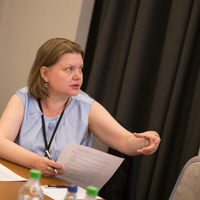
Terry Sohl
Phone: 605-594-6537
Address: USGS Earth Resources Observation and Science (EROS) Center
47914 252nd Street
Sioux Falls, SD 57198
Address: USGS Earth Resources Observation and Science (EROS) Center
47914 252nd Street
Sioux Falls, SD 57198
less
Related Authors
Abdullahi Chado Salihu
Nigerian Army University Biu
C. Ward-garrison
Colorado School of Mines
Germán Poveda
Universidad Nacional de Colombia (National University of Colombia)
Adnan Rajib
Purdue University
Dr. Santosh Murlidhar Pingale
National Institute of Hydrology, Roorkee
Steven McNulty
North Carolina State University








Uploads
Papers by Terry Sohl
• We developed a unique set of landscape projections
for the Great Plains that use real landmanagement
parcels to represent landscape patterns
at high spatial and thematic resolution.
• Both anthropogenic land use and natural vegetation
respond in the model to projected changes in
groundwater availability and climate change.
• Thirty-three scenario combinations were modeled,
facilitating landscape planning and mitigation efforts
under a range of possible landscape futures.
• Change in rangeland from 2014 to 2100 varied
from an increase of 4.3% for the Special Report on
Emissions Scenarios (SRES) B2 scenario, to a
decline of 23.6% for the SRES A1B scenario.
• The spatially and thematically detailed projections are
designed for the assessment of landscape interactions
with water flow and water quality, species
distribution and abundance modeling, greenhouse
gas assessments, and other ecosystem services.
contiguous ownership and management units (parcels), yet LULC models primarily use pixel-based spatial frameworks. The few parcel-based models being used overwhelmingly focus on small geographic areas, limiting the ability to assess LULC change impacts at regional to national scales. We developed a modified version of the Forecasting Scenarios of land use change model to project parcel-based agricultural change across a large region in the United States Great Plains. A scenario representing an agricultural biofuel scenario was modeled from 2012 to 2030, using real parcel boundaries based on contiguous ownership and land management units. The resulting LULC projection provides a vastly improved representation of landscape pattern over existing pixel-based models, while simultaneously providing an unprecedented combination of thematic detail and broad geographic extent. The conceptual approach is practical and scalable, with potential use for national-scale projections.
2.6, RCP 4.5, RCP 6.0, and RCP 8.5) at a 1 km resolution within a globally consistent framework. The data are freely available for download, and will enable researchers to study the impacts of LULC change at the local scale.
The Department of Interior, and the Nation in general, have a vast array of information needs. The USGS meets these needs by having a broadly trained and agile scientific workforce. Encouraging and supporting cross-discipline engagement would position the USGS to tackle complex and multifaceted scientific and societal challenges in the 21st Century.
feedbacks between land and climate changes in both reality and models. To this end, one critical cross-disciplinary need is to systematically quantify and better understand measurement and model uncertainties. Finally, LCLUC mitigation and adaptation assessments must be strengthened to identify implementation barriers, evaluate and prioritize opportunities, and examine how decisionmaking processes work in specific contexts.
Land use and land cover (LULC) data are important predictor variables for determining species range, yet are rarely used
when modeling future distributions. In this study, maximum entropy modeling was used to construct species distribution
maps for 50 North American bird species to determine relative contributions of climate and LULC for contemporary (2001)
and future (2075) time periods. Species presence data were used as a dependent variable, while climate, LULC, and
topographic data were used as predictor variables. Results varied by species, but in general, measures of model fit for 2001
indicated significantly poorer fit when either climate or LULC data were excluded from model simulations. Climate
covariates provided a higher contribution to 2001 model results than did LULC variables, although both categories of
variables strongly contributed. The area deemed to be ‘‘suitable’’ for 2001 species presence was strongly affected by the
choice of model covariates, with significantly larger ranges predicted when LULC was excluded as a covariate. Changes in
species ranges for 2075 indicate much larger overall range changes due to projected climate change than due to projected
LULC change. However, the choice of study area impacted results for both current and projected model applications, with
truncation of actual species ranges resulting in lower model fit scores and increased difficulty in interpreting covariate
impacts on species range. Results indicate species-specific response to climate and LULC variables; however, both climate
and LULC variables clearly are important for modeling both contemporary and potential future species ranges.
fluxes of other GHGs. National-scale, comprehensive analyses of carbon sequestration potential by ecosystem are needed, with a consistent, nationally applicable land-use and land-cover (LULC) modeling framework a key component of such analyses. The U.S. Geological Survey has initiated a project to analyze current and projected future GHG fluxes by ecosystem and quantify potential mitigation strategies. We have developed a unique LULC modeling framework to support this work. Downscaled scenarios consistent with IPCC Special Report on Emissions Scenarios (SRES) were constructed for U.S. ecoregions, and the FORE-SCE model was used to spatially map the scenarios. Results for a prototype demonstrate our ability to model LULC change and inform a biogeochemical modeling framework for analysis of subsequent GHG fluxes. The methodology was then successfully used to model LULC change
for four IPCC SRES scenarios for an ecoregion in the Great Plains. The scenario-based LULC projections are now being used to analyze potential GHG impacts of LULC change across the U.S.
an array of biophysical and socioeconomic processes across multiple spatial and temporal scales, and acquiring and utilizing empirical data to support the analysis of those processes. The Southeastern and Pacific Northwest regions of the United States, two heavily forested regions with significant forest industries, are examined in the context of these foundational
elements. Geographic setting fundamentally affects both the primary land cover (forest) in the two regions, and the structure and form of land use (forestry). Land-use histories of the regions can be used to parameterize land-use models, validate model performance, and explore land-use scenarios. Drivers
of change in the two regions are many and varied,
with issues of scale and complexity posing significant
challenges. Careful scenario development can be
used to simplify process-based land-use models, and
can improve our ability to address specific research
questions. The successful modeling of land-use
change in these two areas requires integration of
both top-down and bottom-up drivers of change,
using scenario frameworks to both guide and simplify
the modeling process. Modular approaches, with
utilization and integration of existing process models,
allow regional land-use modelers the opportunity to
better represent primary drivers of land-use change.
However, availability of data to represent driving
forces remains a primary obstacle.
proportions of land cover for this application were provided by ecoregion-based extrapolations of historical change. Logistic regression was used to develop relationships between
suspected drivers of land-cover change and land cover, resulting in the development of probability-of-occurrence surfaces for each unique land-cover type. Forest stand age was initially established with Forest Inventory and Analysis (FIA) data and tracked through model iterations. The spatial allocation procedure placed patches of new land cover on the landscape
until the scenario prescriptions were met, using measured Land Cover Trends data to guide patch characteristics and the probability surfaces to guide placement. The approach
provides an efficient method for extrapolating historical land-cover trends and is amenable to the incorporation of more detailed and focused studies for the establishment of scenario
prescriptions.
conterminous United States. The newly developed FORE-SCE model used Land Cover Trends data and theoretical, statistical, and deterministic modeling techniques to project future land cover change through 2020 for multiple plausible scenarios. Projected proportions of future land use were initially developed, and then sited on the lands with the highest potential for supporting that land use and land cover using a statistically based stochastic allocation procedure. Three
scenarios of 2020 land cover were mapped for the western Great Plains in the US. The model provided realistic, high-resolution, scenario-based land-cover products suitable for multiple applications, including studies of climate and
weather variability, carbon dynamics, and regional hydrology.
• We developed a unique set of landscape projections
for the Great Plains that use real landmanagement
parcels to represent landscape patterns
at high spatial and thematic resolution.
• Both anthropogenic land use and natural vegetation
respond in the model to projected changes in
groundwater availability and climate change.
• Thirty-three scenario combinations were modeled,
facilitating landscape planning and mitigation efforts
under a range of possible landscape futures.
• Change in rangeland from 2014 to 2100 varied
from an increase of 4.3% for the Special Report on
Emissions Scenarios (SRES) B2 scenario, to a
decline of 23.6% for the SRES A1B scenario.
• The spatially and thematically detailed projections are
designed for the assessment of landscape interactions
with water flow and water quality, species
distribution and abundance modeling, greenhouse
gas assessments, and other ecosystem services.
contiguous ownership and management units (parcels), yet LULC models primarily use pixel-based spatial frameworks. The few parcel-based models being used overwhelmingly focus on small geographic areas, limiting the ability to assess LULC change impacts at regional to national scales. We developed a modified version of the Forecasting Scenarios of land use change model to project parcel-based agricultural change across a large region in the United States Great Plains. A scenario representing an agricultural biofuel scenario was modeled from 2012 to 2030, using real parcel boundaries based on contiguous ownership and land management units. The resulting LULC projection provides a vastly improved representation of landscape pattern over existing pixel-based models, while simultaneously providing an unprecedented combination of thematic detail and broad geographic extent. The conceptual approach is practical and scalable, with potential use for national-scale projections.
2.6, RCP 4.5, RCP 6.0, and RCP 8.5) at a 1 km resolution within a globally consistent framework. The data are freely available for download, and will enable researchers to study the impacts of LULC change at the local scale.
The Department of Interior, and the Nation in general, have a vast array of information needs. The USGS meets these needs by having a broadly trained and agile scientific workforce. Encouraging and supporting cross-discipline engagement would position the USGS to tackle complex and multifaceted scientific and societal challenges in the 21st Century.
feedbacks between land and climate changes in both reality and models. To this end, one critical cross-disciplinary need is to systematically quantify and better understand measurement and model uncertainties. Finally, LCLUC mitigation and adaptation assessments must be strengthened to identify implementation barriers, evaluate and prioritize opportunities, and examine how decisionmaking processes work in specific contexts.
Land use and land cover (LULC) data are important predictor variables for determining species range, yet are rarely used
when modeling future distributions. In this study, maximum entropy modeling was used to construct species distribution
maps for 50 North American bird species to determine relative contributions of climate and LULC for contemporary (2001)
and future (2075) time periods. Species presence data were used as a dependent variable, while climate, LULC, and
topographic data were used as predictor variables. Results varied by species, but in general, measures of model fit for 2001
indicated significantly poorer fit when either climate or LULC data were excluded from model simulations. Climate
covariates provided a higher contribution to 2001 model results than did LULC variables, although both categories of
variables strongly contributed. The area deemed to be ‘‘suitable’’ for 2001 species presence was strongly affected by the
choice of model covariates, with significantly larger ranges predicted when LULC was excluded as a covariate. Changes in
species ranges for 2075 indicate much larger overall range changes due to projected climate change than due to projected
LULC change. However, the choice of study area impacted results for both current and projected model applications, with
truncation of actual species ranges resulting in lower model fit scores and increased difficulty in interpreting covariate
impacts on species range. Results indicate species-specific response to climate and LULC variables; however, both climate
and LULC variables clearly are important for modeling both contemporary and potential future species ranges.
fluxes of other GHGs. National-scale, comprehensive analyses of carbon sequestration potential by ecosystem are needed, with a consistent, nationally applicable land-use and land-cover (LULC) modeling framework a key component of such analyses. The U.S. Geological Survey has initiated a project to analyze current and projected future GHG fluxes by ecosystem and quantify potential mitigation strategies. We have developed a unique LULC modeling framework to support this work. Downscaled scenarios consistent with IPCC Special Report on Emissions Scenarios (SRES) were constructed for U.S. ecoregions, and the FORE-SCE model was used to spatially map the scenarios. Results for a prototype demonstrate our ability to model LULC change and inform a biogeochemical modeling framework for analysis of subsequent GHG fluxes. The methodology was then successfully used to model LULC change
for four IPCC SRES scenarios for an ecoregion in the Great Plains. The scenario-based LULC projections are now being used to analyze potential GHG impacts of LULC change across the U.S.
an array of biophysical and socioeconomic processes across multiple spatial and temporal scales, and acquiring and utilizing empirical data to support the analysis of those processes. The Southeastern and Pacific Northwest regions of the United States, two heavily forested regions with significant forest industries, are examined in the context of these foundational
elements. Geographic setting fundamentally affects both the primary land cover (forest) in the two regions, and the structure and form of land use (forestry). Land-use histories of the regions can be used to parameterize land-use models, validate model performance, and explore land-use scenarios. Drivers
of change in the two regions are many and varied,
with issues of scale and complexity posing significant
challenges. Careful scenario development can be
used to simplify process-based land-use models, and
can improve our ability to address specific research
questions. The successful modeling of land-use
change in these two areas requires integration of
both top-down and bottom-up drivers of change,
using scenario frameworks to both guide and simplify
the modeling process. Modular approaches, with
utilization and integration of existing process models,
allow regional land-use modelers the opportunity to
better represent primary drivers of land-use change.
However, availability of data to represent driving
forces remains a primary obstacle.
proportions of land cover for this application were provided by ecoregion-based extrapolations of historical change. Logistic regression was used to develop relationships between
suspected drivers of land-cover change and land cover, resulting in the development of probability-of-occurrence surfaces for each unique land-cover type. Forest stand age was initially established with Forest Inventory and Analysis (FIA) data and tracked through model iterations. The spatial allocation procedure placed patches of new land cover on the landscape
until the scenario prescriptions were met, using measured Land Cover Trends data to guide patch characteristics and the probability surfaces to guide placement. The approach
provides an efficient method for extrapolating historical land-cover trends and is amenable to the incorporation of more detailed and focused studies for the establishment of scenario
prescriptions.
conterminous United States. The newly developed FORE-SCE model used Land Cover Trends data and theoretical, statistical, and deterministic modeling techniques to project future land cover change through 2020 for multiple plausible scenarios. Projected proportions of future land use were initially developed, and then sited on the lands with the highest potential for supporting that land use and land cover using a statistically based stochastic allocation procedure. Three
scenarios of 2020 land cover were mapped for the western Great Plains in the US. The model provided realistic, high-resolution, scenario-based land-cover products suitable for multiple applications, including studies of climate and
weather variability, carbon dynamics, and regional hydrology.